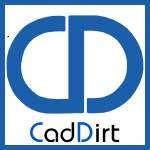Unboxing the uPrint 3D Printer
/This past week I received one of our new Dimension uPrint 3D printers and was anxious to set the machine up and begin printing. The uPrint is a personal desktop 3D printer whose setup experience has been designed to mimic that of a standard peripheral desktop printer. Having heard this, I wanted to open the printer and experience this for myself. I tried to control my excitement enough to pause the opening along the way in order to take a picture or two for documentation purposes.
The uPrint itself stands 31" tall with a footprint of 25" x 26" so the machine itself is about the size of a wine refrigerator except a bit more heavy weighing in at 168 lbs. The machine sits on a material bay that houses the two material cartridges which then sits on the desk. I think it would be nice to keep in on a cart so it can be moved around the office.
The boxes contained the printer, the material base, and the starter kit. The starter kit has on it's lid in big red letters "OPEN THIS FIRST". The contents of this box contains a variety of tools, cables, software and the required few parts needed to get the printer unpacked and running as well as the a set of material reels. Also included in this box was a poster sized setup instructions with all pictures! The verbiage, for the most part, was single sentenance instructions displaying a true step-by-step setup.
The setup was rather easy, setting the material bay on a table, setting the uPrint 3D Printer on top of that, connecting the material bay with the
supplied cable and delivery tubes to each material type. Now that the machine is connected it was time for power! The remainder of the setup was done on the display screen for procedures like loading the material and allowing the machine calibrate itself. The uPrint machine interfaces with it's users through a network interface either via crossover cable directly to a computer or via standard network cable directly into a switch. The system does support DHCP so you can just plug it in and be able to print. I opted to use the STATIC setup so I could specify an IP that could be shared with the other offices. The CatylistEX software was also a snap to install, automatically detecting the network attached printer and displaying it's status on the screen.
After unpacking the system, plugging it into the network, and installing the software, I was ready to print! Usually these systems take time to setup and calibrate but with the uPrint this was about a 30 minute ordeal and the system was up and running and printing my parts from SolidWorks.
The workflow to print parts is extremely straight forward. Save an STL file out of SolidWorks and open the STL inside of the CatylistEX software. From there you can orient and/or scale the model, send it to the "Pack" which allows you to place it on the ABS base inside the machine then you hit Print! It really is that easy and the parts come out of the machine ready to use!
The print envelope of the uPrint 3D printer is 6" deep by 8" wide by 6" tall and has a variety of settings for both the density of the ABS Plus material as well as the support material which dissolves. The uPrint currently only prints in the ivory color and uses the soluble support material that can dissolved in a bath of Sodium Hydroxide (NaOH) detergent. This dissolving process can be sped up with a temperature agitation bath which we opted to get in order turn around parts quickly.
Overall the experience for someone who has purchased this machine is unbox to print in about 30-40minutes! It is obvious Dimension has put some design into making this machine a true peripheral that can be utilized by anyone without any special training or extensive setup time. As 3D Printers like the uPrint (MSRP $14,900) become less expensive and easier to use out of the box, engineering departments everywhere will begin to incorporate this technology into product development! ~Lou

